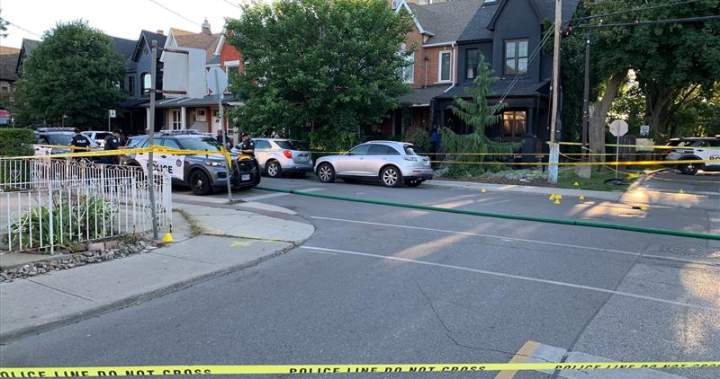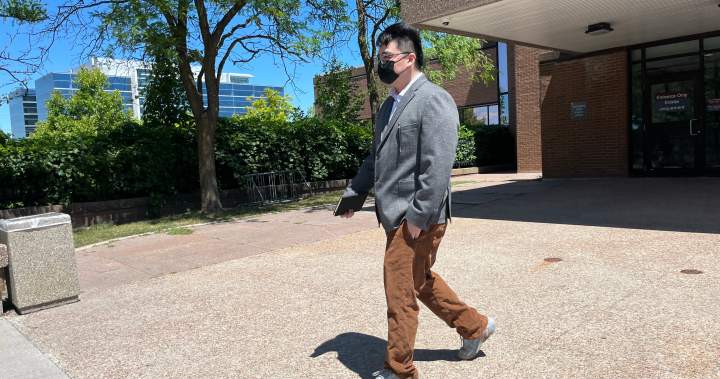Uncategorized
Gausman has best stuff in clutch win over Yankees

TORONTO – The first two innings have never been Kevin Gausman’s forte but when he gets off to a quick start he knows it’s going to be a good game.
Gausman struck out Trent Grisham and two-time American League MVP Aaron Judge in the first two at bats of the Toronto Blue Jays’ 4-1 victory over the New York Yankees on Monday night. Gausman struck out eight and gave up just one run over seven innings as Toronto earned a critical win over the rival Yankees.
That one-two punchout was when Gausman knew he had his best stuff.
“Unfortunately for me, I’m usually not very good at the first two innings. My career ERA would be so much lower if, you know, I could figure that out,” said Gausman, who has a 3.86 earned-run average over his career, although he has a 4.69 ERA in the first inning and a 3.32 ERA in the second over his 13 Major League Baseball seasons.
“But when I’m able to come out and establish the fastball and throw swing-and-miss splitters straight out the jump, I feel pretty confident that I can go seven innings or even more.”
Related Videos
Gausman fell behind Judge 2-0 in the first inning but then got him out with a swinging strike on a four-seam fastball, a foul ball on another four-seamer followed by another swinging strike on a splitter.

Get breaking National news
For news impacting Canada and around the world, sign up for breaking news alerts delivered directly to you when they happen.
The two battled again in the fifth with Oswald Peraza on third base and two outs.
Gausman jumped out to a quick 0-2 count in that at bat but Judge drew a pair of balls to even it 2-2. Judge fouled off three-consecutive four-seamers that were all over 96 miles per hour, before he popped up an 84.6 m.p.h. splitter to catcher Alejandro Kirk to end the top of the inning.
“That’s kind of mano a mano,” said Gausman of the impressive showing against Judge. “If he gets a hit, it’s going to score a run, and if I get him out, I’m out of the inning so definitely tried to throw my best fastballs.
“If you look at my numbers, they’re not too great against him. He’s had a lot of success against me. I’ve struck him out a good bit, but he’s a two-time MVP for a reason.”
The sold-out Rogers Centre crowd of 41,786 seemed to appreciate Gausman’s battles against Judge, with a loud ovation when Kirk caught the pop-fly in foul territory.
“(Gausman) was awesome,” said Blue Jays manager John Schneider. “Kind of what you expect out of a veteran guy to get the series going.
“Huge at bat versus Judge in the fifth. That was a good battle. Came after him with heaters, but Kev, he was in total control. Really, really good performance.”
It was Toronto’s (59-41) fourth win in a row and seventh in 10 games. The Blue Jays added to their lead atop the AL East, four games ahead of New York.
“Anytime you can go seven innings, against a division rival is going to be big, especially the first game of a series, rest some of those guys out there (in the bullpen),” said Gausman. “If you can get a little bit further, it’s going to set things up nice for the rest of the series.”
The Yankees have two more games at Rogers Centre in the series. Toronto has a Major League Baseball-best 36-16 record at home so far this season and has won a franchise-best 11 consecutive games at Rogers Centre.
“I think that the city and the fans deserve that,” said Schneider. “We love the support. You look up at 6:45 p.m. and the place is full.
“It’s a really cool feeling and the guys, they feel that. Everyone feels that.”
This report by The Canadian Press was first published July 21, 2025.
© 2025 The Canadian Press
Uncategorized
Videos in hockey players’ trial highlight misconceptions about consent: law experts

As five former Canadian world junior hockey players await a ruling in their sexual assault trial, legal experts say videos shown in court of the complainant saying she was OK with what had happened highlight a broader misunderstanding of consent and sexual assault law in Canada.
Two cellphone videos in which the woman says she’s “OK with this” and that “it was all consensual” were presented as evidence during the trial of Michael McLeod, Carter Hart, Alex Formenton, Dillon Dube, and Callan Foote.
All five men have pleaded not guilty to sexual assault after an encounter in a London, Ont., hotel room in the early morning hours of June 19, 2018. McLeod has also pleaded not guilty to an additional charge of being a party to the offence of sexual assault.
Ontario Superior Court Justice Maria Carroccia is expected to deliver her ruling on Thursday in the case that saw consent emerge as a central issue.
Prosecutors have argued the complainant did not voluntarily agree to the sexual acts that took place, nor did the players take reasonable steps to confirm her consent. The Crown has dismissed the videos taken of the woman that night as “token lip service box checking,” arguing she felt she had no choice but to go along when a group of men she didn’t know started asking her to do things inside the hotel room.
Defence lawyers, meanwhile, repeatedly challenged the complainant’s credibility and reliability as a witness, arguing she was an active participant in the sexual activity and made up the allegations because she didn’t want to take responsibility for her choices that night.
Video statements such as the short clips shown in this trial aren’t necessarily evidence of consent, said University of Ottawa law professor Daphne Gilbert.

Get breaking National news
For news impacting Canada and around the world, sign up for breaking news alerts delivered directly to you when they happen.
“Legally speaking, they have very little relevance because consent has to be ongoing and contemporaneous with the sexual activity and you have to be consenting to every single thing that is happening to you,” said Gilbert, who researches sexual violence and abuse in Canadian sports.
“There’s no such thing as advance consent. And there’s no thing as after-the-fact consent, either. So just because you say, ‘Yeah, it was all consensual’ doesn’t mean that makes it so.”

Lisa Dufraimont, a law professor at York University, said such videos could also be seen as hearsay because they don’t contain statements made under oath in court.
“If the complainant got on the stand at the trial and testified that they consented at the time, that would be evidence that they consented at the time,” said Dufraimont, whose research focuses on evidence issues in sexual assault cases.
But she said the videos could be used for other legal arguments, including those that may rely on a description of how a defendant or complainant was acting at the time.
“It may be that if the video is taken close in time to the alleged sexual assault, that the video shows something about the person’s level of intoxication or their emotional state, which may or may not be consistent with what they later reported their emotional state was at the time,” said Dufraimont.
During the trial, the Crown argued that the videos shown in court weren’t proof that the complainant voluntarily agreed to what had taken place.
“The recording of that video is not getting her consent to anything. Everything’s already happened,” prosecutor Meaghan Cunningham said about the video in which the woman said it was “all consensual,” adding that consent must be communicated for each specific act at the time it takes place.
Only one of the accused, Hart, took the stand in his own defence, and court heard or watched interviews three of the others — McLeod, Formenton and Dube — gave police in 2018. People accused of crimes are not required to testify, nor is the defence required to call any evidence, as it is up to the Crown to prove guilt beyond a reasonable doubt.
In McLeod’s 2018 interview with police, he told a detective that he recorded one of the videos because he was “just kind of worried something like this might happen.”
On the stand, Hart testified that consent videos aren’t unusual for professional athletes.
Gilbert, the University of Ottawa law professor, said Canada in general still has work to do in educating young people about consent, especially in sports. She’s involved in efforts to teach youth about consent through school programming, but said professional hockey in particular is behind on enacting policies to address the issue.
Consent should be “enthusiastic, affirmative, ongoing, coherent” — yes means yes, said Gilbert.
“I think people don’t understand that that’s actually what the law requires. And so if you know that, if you think about that as the way that we should approach consent, then I think it’s easier to understand why those videos don’t mean much.”
© 2025 The Canadian Press
Uncategorized
Man dead after shooting in Toronto


Toronto police say a man has died after a shooting on Tuesday morning.
Source link
Uncategorized
Trial begins for Markham man accused of crash that killed off-duty officer

Sitting in the front row of a fourth-floor courtroom in Newmarket on Monday, the mother of Travis Gillespie clutched her late son’s forged cap, the police hat which the 38-year-old constable wore while in uniform with York Regional Police. Gillespie’s family and friends lining the front row of the gallery.
They were there for the opening day of the dangerous and impaired driving causing death trial for 26-year-old Haoju Zhou.
Crown attorney Sean Doyle told Superior Court Justice Mark Edwards that evidence will show that Zhou, who was a G2 driver at the time of the collision and was prohibited from having any alcohol in his blood while driving, is guilty of both offences.
Zhou has pleaded not guilty.
Timothy Dixon testified he was driving to work with three co-workers around 6 am om September 14, 2022 westbound along Major Mackenzie Drive west of Warden Avenue in Markham. Dixon said he saw headlights and thought an oncoming car was coming right towards him.
“I said ‘holy sh-t. I cranked the vehicle from the left-lane to the right-hand lane. It hit the car behind me instantaneously. I was slowing down and craning behind me. I could see a car up in the air spinning in circles,” said Dixon referring to the car behind him.
That car, a white Honda Accord, was being driven by Travis Gillespie, an off-duty police constable who was on his way to York Regional Police’s #2 District in Richmond Hill.
Court heard Gillespie was in the westbound passing lane and behind him, in the curb lane was a dump truck operated by Dhaneshwar Hardial. Hardial testified as he was driving up a hill, he heard a loud noise and later realized a white car had struck his truck.
Hardial testified he called 911 but didn’t speak to any of the drivers involved. Dixon who told court the road way dry said he spoke to Zhou, after realizing he was the driver of the black Porsche SUV that had collided with Gillespie’s Honda.

Get breaking National news
For news impacting Canada and around the world, sign up for breaking news alerts delivered directly to you when they happen.
“The driver of the vehicle was walking down towards me and he was asking ‘is he okay? is he okay?” said Dixon. He said the driver was very emotional and crying and said he wanted to use the phone.
“He said ‘I’m so tired, I fell asleep. I’m so tired. He was so emotional,” said Dixon adding Zhou wanted to hug him. “He gave me one. He wanted to hug me again. I said ‘once is enough’”.
Dixon said he detected an odour of a really bad air freshener. “Whatever the odour was, I could taste it, like a pine tree. He borrowed the tow truck driver’s phone and phoned home. By this time, police had taken him from me,” Dixon added.
Doyle told court that Gillespie died at the scene. “The cause of death was multiple trauma,” said Doyle.
During cross-examination, defence counsel Paul Aubin asked Dixon if he smelled alcohol on Zhou. Dixon said no and agreed Zhou wasn’t slurring his word. “He asked me if a person died in the car,” said Dixon who remembered he was fidgeting and couldn’t sit still.
One of the first officers on scene, Constable Sean Lee testified when he arrived, he saw the black Porsche Cayenne with severe front end damage. He said a white man pointed out an asian male that was the driver of the Porsche.
“I walked towards the asian male and prior to either of us saying anything, he stretched out his arms in an “arrest me gesture,” said Lee. “I was confused and I recall asking why are you doing that?” Lee said Zhou said in english, “I will cooperate”.
“Immediately I formed suspicion in my mind that this may be a criminal investigation for impaired operation,” said Lee who recalled that Zhou was swaying side to side as he was speaking to him. “I did observe his eyes were glossy, one of the indicia of impairment by alcohol,” he added.
The other officer who arrived on scene at the same time as Lee, Const. Ryan Krkachovski said he arrested Zhou for impaired after Lee instructed him to do so. He said after Zhou was in custody , he escorted him from one ambulance to another and thought he was stumbling and his gait was off. “He was not walking in a straight line,’ Kr\kachovski told court.
He said later after accompanying Zhou to Markham-Stouffville Hospital and arresting him for impaired driving causing death, Zhou suddenly said to him “the curb was too tight”. Krkachovski said he told him to stop talking since he hadn’t spoken to a lawyer. Krkachovski said he noticed a “sweet odour about him” but during cross-examination, couldn’t say he made any observations of impairment.
Doyle told court that the posted speed limit for traffic on Major Mackenzie Drive in the area of the collision is 70 km/hr. He said on impact, the Porsche SUV was travelling between 69-76 km/hour but no data is available in relation to braking or steering control. “The Honda Accord was travelling at 84 km/hour. The brakes were not applied at any time and the steering input was minimal,” said Doyle.
Doyle said two blood samples were drawn from Zhou at Markham Stouffville hospital at 8:11 am and again at 9:13 am and were sent for analysis at the Centre for Forensic Sciences.
The crown said an expert in the field of forensic toxicology is expected to testify that blood drawn at 8:11 am contained 80 mg of alcohol in 100 ml of blood. “That result would equate to a blood alcohol concentration of between 82 and 130 mg of alcohol in 100 ml of blood around the time of the collision.
The blood drawn at 9:13 a.m. contained 58 mg of alcohol, said Doyle, equated to a BAC of between 70-128 mg/100 ml of blood around the time of the collision.
Doyle said the forensic toxicologist will testify the hospital’s own analysis of the blood drawn at 8:11 am converted to 92 mg of alcohol per 100 ml of blood at the time of the collision.
Doyle said the crown must prove that Zhou’s ability to operate the motor vehicle was impaired to any degree by alcohol or that his blood-alcohol concentration within two hours of ceasing to operate the motor vehicle was equal of greater to 80 mg of alcohol in 100 ml of blood.
“The crown will lead evidence to prove both,” said Doyle. He added that the crown asserts that Zhou operated his motor vehicle in a manner, that having regard to all the circumstances, is dangerous to the public and was not a momentary lapse in judgement.
The trial continues.
© 2025 Global News, a division of Corus Entertainment Inc.
-

 Uncategorized1 month ago
Uncategorized1 month agoThese ’90s fashion trends are making a comeback in 2017
-

 Uncategorized1 month ago
Uncategorized1 month agoAccording to Dior Couture, this taboo fashion accessory is back
-

 Uncategorized1 month ago
Uncategorized1 month agoThe old and New Edition cast comes together to perform
-

 Uncategorized1 month ago
Uncategorized1 month agoUber and Lyft are finally available in all of New York State
-

 Uncategorized1 month ago
Uncategorized1 month agoNew Season 8 Walking Dead trailer flashes forward in time
-

 Uncategorized1 month ago
Uncategorized1 month agoMeet Superman’s grandfather in new trailer for Krypton
-

 Uncategorized1 month ago
Uncategorized1 month ago6 Stunning new co-working spaces around the globe
-

 Uncategorized1 month ago
Uncategorized1 month agoThe final 6 ‘Game of Thrones’ episodes might feel like a full season







